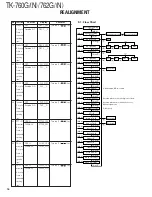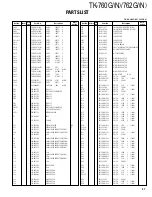
28
TK-760G/
(
N
)
/762G/
(
N
)
■
D/A Converter
The D/A converter (IC6) is used to adjust TONE and MO
modulation, AF volume, TV voltage, FC reference voltage,
and PC POWER CONTROL voltage level.
Adjustment values are sent from the CPU as serial data.
The D/A converter has a resolution of 256 and the following
relationship is valid:
D/A output = (Vin – VDAref) / 256 x n + VDAref
Vin: Analog input
VDAref: D/A reference voltage
n: Serial data value from the microprocessor (CPU)
■
Horn Control
The horn switch, consisting of Q1, Q5, and Q6, controls
the horn relay. It is supplied by the dealer to provide the
external horn alert function.
Q6 disables horn alert, turning on when its base is high,
to inhibit the function. Normally, the output from IC9 is low,
and Q5 is off; the base of Q1 is about 0V and Q1 is off.
When horn alert is enabled, the output from IC9 goes high
and Q5 turns on. The base current flows through R21 to Q1
to turn Q1 on. Q1 can sink a maximum of 100mA. If the
optional KAP-1 is used, it can drive up to 2A.
■
Decode
• QT/DQT/DTMF
The signal (DEO) detected by the TX-RX unit passes
through two low-pass filters of IC513, goes to TOI of the
CPU (IC502) to decode QT, DQT. The DTMF signal is de-
coded by a dedicated IC (IC511) and the resulting signal is
sent to the CPU (IC502) as serial data.
• 2-tone, 5-tone
The detected signal passes through audio processor
(IC508) RX OUT. Then it is filtered through IC514 2-stage
low-pass filtered to enter CPU (IC502) to decode 2-tone and
5-tone signalling.
CIRCUIT DESCRIPTION
Fig. 14
Decode
IC502
CPU
IC513(2/2)
LPF
IC513(1/2)
LPF
TOI
IC511
DTMF
DECO.
IC508
Audio
processor
STD
DEO
IC514(2/2)
LPF
IC514(1/2)
LPF
2TN
RXOUT
8C
HOR
D2
Q1
Q5
R21
Q6
R3
R135
+B
IC9
HNC
IGN
Fig. 15
Horn control circuit
Q23
SW
Q19
SW
Q20
SW
Q26
INV.
IC14
F.F.
Q21
SW
D21
SW
R135
R134
IGN
SB
+B
PSW
Fig. 17
Power supply circuit
■
PA Switch
If the optional KAP-1 is used (see the separate section for
details), the PA (Public Address) function becomes available.
In this case, the signal flow changes as follows;
• PA off
For TX, the switch which is between pins 10 and 11 of
IC509 closes. The audio signal from the microphone passes
through IC509 and IC6 and modulates the VCO.
For RX, the switch which is between pins 3 and 4 of
IC509 closes. The detected signal passes through IC509,
IC508, IC507, IC6 and IC13 and is then output to the
speaker.
• PA on
Since the switch which is between pins 10 and 11 of
IC509 is open, the switch which is between pins 3 and 4 of
IC509 is open, and the switch which is between pins 1 and 2
of IC509 is closed, the audio signal from the microphone
passes through IC508, IC507 and IC6, and then goes to
IC13. The signal is output to the external PA system
through the PA relay in KAP-1.
Power Supply Circuit
When the POWER switch on the control unit is pressed,
the PSW signal goes low. This signal is inverted by Q26 and
sent to a flip-flop IC (IC14). This IC outputs a control signal
when the PSW goes low. When the power turns on, pin 1
of IC14 outputs a low signal and Q20 turns on. The base of
Q19 goes high, Q19 turns on, SB SW (Q23) turns on and
power (SB) is supplied to the set.
This circuit has an overvoltage protection circuit. If a DC
voltage of 20 V or higher is applied to the power cable, D21
turns on and a voltage is applied to the base of Q21. This
voltage turns Q21 on and turns Q19 and SBSW off.
10
2
4
11
1
3
DEO
MB
VCO
MIC
IC507
IC508
IC509
IC6
OP AMP
Audio
processor
Analog SW
D/A
converter
IC13
Power AMP
SP
(INT/EXT)
PA
KAP-1
(Option)
Fig. 16
PA switch
















































